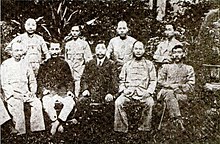Second Guangzhou Uprising
| Second Guangzhou Uprising | |||||||
|---|---|---|---|---|---|---|---|
| Part of the Xinhai Revolution | |||||||
 Yellow Flower Mound Park and the Mausoleum of the 72 Martyrs | |||||||
| |||||||
| Belligerents | |||||||
|
|
| ||||||
| Commanders and leaders | |||||||
| Huang Xing | Zhang Jianbo | ||||||
| Strength | |||||||
| 120 | Thousands | ||||||
| Casualties and losses | |||||||
| 86 |
| ||||||
| Second Guangzhou Uprising | ||
|---|---|---|
Hanyu Pinyin Huánghuāgǎng zhī Yì | | |
| Yue: Cantonese | ||
| Jyutping | Wong4 Faa1 Gong1 zi1 Jik6 | |
The Second Guangzhou (Canton) Uprising, known in Chinese as the Yellow Flower Mound Uprising or the Guangzhou Xinhai Uprising, was a failed uprising took place in China led by Huang Xing and his fellow revolutionaries against the Qing dynasty in Canton (Guangzhou). It is honored in Guangzhou's Yellow Flower Mound or Huanghuagang Park.
History

At this time
Huang Xing and nearly a hundred fellow revolutionaries forced their way into the residence of the
Legacy
The dead were buried together in one grave on the Yellow Flower Mound, a mound near where they fought and died which has lent its name to the uprising.[2] After the Chinese revolution, a cemetery was built on the mound with the names of those 72 revolutionary nationalists. They were commemorated as the "72 martyrs."[2] Some historians believe that the uprising was a direct cause of the
Memorials
The uprising is remembered annually in Taiwan on March 29, as Youth Day.[6]
-
The Mausoleum of the 72 Martyrs, topped by the Statue of Liberty.
-
Yellow Flower Mound Park.
In popular culture
The 1980 film Magnificent 72 and the 2011 film 72 Heroes focus on the uprising. Events of the uprising open the 2011 film 1911.
See also
- Xinhai Revolution
References
- ISBN 978-983-42834-8-3. pp. 50, 62, 122.
- ^ ISBN 962-8885-28-6. pp. 195–198.
- ^ 余世存. 名人传记:黄兴家族百年沧桑 (in Chinese). pp. 4–10.
- ^ "中國窗-香港商報電子報". Cnwnc.com. Retrieved 2011-10-12.[dead link]
- ISBN 978-0-313-37853-9. pp. 5–6.
- ^ "Youth Day". Government Information Office, ROC. Archived from the original on 31 March 2012. Retrieved 11 March 2012.


